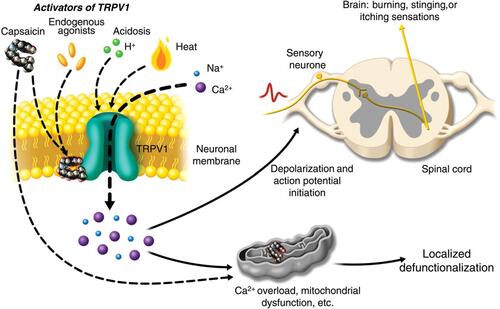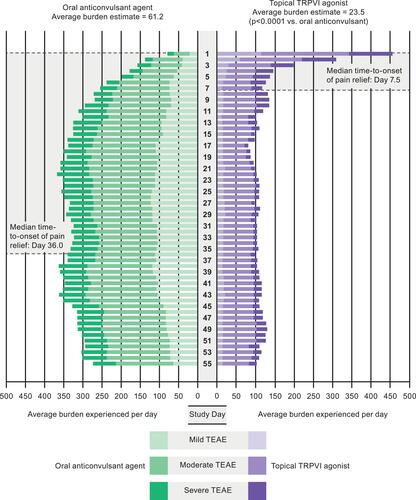Figures & data
Table 1 Summary of Key Guideline and Consensus Recommendations for Pharmacotherapy in Neuropathic Pain
Figure 1 Mechanism of action of capsaicin in treatment of localized peripheral neuropathic pain. Activation of transient receptor potential vanilloid-1 (TRPV1) by capsaicin results in sensory neuronal depolarization, and can induce local sensitization to activation by heat, acidosis, and endogenous agonists. Topical exposure to capsaicin leads to the sensations of heat, burning, stinging, or itching. High concentrations of capsaicin or repeated applications can produce a persistent local effect on cutaneous nociceptors, which is best described as “defunctionalization” and constituted by reduced spontaneous activity and a loss of responsiveness to a wide range of sensory stimuli. .Reproduced from Anand P, Bley K. Topical capsaicin for pain management: therapeutic potential and mechanisms of action of the new high-concentrationcapsaicin 8% patch. Br J Anaesth. 2011;107(4):490–502, Copyright 2011, with permission from Elsevier.Citation19

Figure 2 BURDEN OF THERAPY™© in a peripheral neuropathic pain study. TEAE, treatment-emergent adverse event; TRPV1, transient receptor potential vanilloid-1. Reproduced from Abdulahad AK, Snijder RJ, Panni MK, Riaz FK, Karas AJ. A novelstandard to evaluate the impact of therapeutic agents on patientsafety – the BURDEN OF THERAPY™©. Contemp Clin Trials Commun. 2016;4:186–191, Copyright 2016, with permission from Elsevier.Citation33

Table 2 The Mean Changes of Pain Intensity Between 7 and 14 Days and 12 Weeks versus Baseline According to the Duration of Pre-Existing Neuropathic Pain in QUEPP
Table 3 Reduction from Baseline to Weeks 2 and 8 in Mean NPRS Score According to PNP Duration in ASCEND
